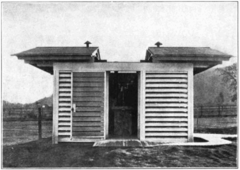International Latitude Observatory
 International latitude observatory of Ukiah, California, 1909 | |
The International Latitude Observatories were a system of (originally) six observatories located near the parallel of 39° 08' north latitude. They were used to measure the variation in latitude that occurs as a result of the "wobble" of the Earth on its polar axis.
The original six observatories were located in:
- Gaithersburg, Maryland
- Cincinnati, Ohio
- Ukiah, California[1]
- Mizusawa, Iwate, Japan
- Charjui, Turkestan
- Carloforte, Italy
History
The International Polar Motion Service[2] program was created by the United States Coast and Geodetic Survey in 1899 to study the precession, or "wobble" of the Earth's axis, and its effect on measures of latitude. Six separate observatories were created along the parallel 39° 08' north latitude. The alignment of all six stations along the parallel helped the observatories to perform uniform data analysis. Twelve groups of stars were studied in the program, each group containing six pairs of stars. Each night, each station observed two of the star groups along a preset schedule and later compared the data against the measurements taken by the sister stations.
Economic difficulties and war caused the closings of some of the original stations, though a newer station was created in Uzbekistan after World War I. The various stations continued to function until advances in computer technology and satellite observations rendered them obsolete in 1982. The data collected by the observatories over the years still has use to scientists, and has been applied to studies of polar motion, the physical properties of the Earth, climatology and satellite tracking and navigation.
The final six observatories were located, in order of Longitude (E to W), in:
- Gaithersburg, Maryland, USA, Gaithersburg Latitude Observatory: N 39:08:12.51 W 77:11:55.85
- Cincinnati, Ohio, USA: N 39:08.3 W 84:25.4
- Ukiah, California, USA: N 39:08:14.26 W 123:12:42.54
- Mizusawa, Japan, National Institutes of Natural Sciences National Astronomical Observatory of Japan, Mizusawa VERA Observatory: N 39:08.1 E 141:07.9
- Kitab, in Uzbekistan: N 39:08.0 E 66:52.9
- Carloforte, Italy: N 39:08:13.76 E 8:18:41.90
External links
- National Park Service - The history of the Gaithersburg Observatory in Maryland, and the overall project.
References
- ↑ Hogle, Gene NAC Green Book of Pacific Coast Touring (1931) National Automobile Club p.43
- ↑ Yokoyama, Koichi; Manabe, Seiji; Sakai, Satoshi (2000). Polar Motion: Historical and Scientific Problems, ASP Conference Series, Vol. 208 (PDF). San Francisco: ASP. pp. 147–162. ISBN 1-58381-039-0. Retrieved 3 September 2014.